Riot Dogs: El Vaquita, Loukanikos & Others Who Joined Protesters Against Police

A stray dog that looks similar to famous riot dog El Vaquita leaps between a demonstrator and police as he’s arrested during a teachers’ protest in Santiago, Chile in June 2015. (AP Photo/Jorge Saenz)
Updated August 28, 2024
August 23, 2020 ~ By Shari Rose
When people protest their government, some stray dogs follow. Known as “riot dogs,” El Vaquita in Chile and Loukanikos in Greece are just a few examples of dogs who famously chose the side of the people in protests against police.
Throughout global protest movements over the last 25 years, there are well-documented cases of stray dogs joining civilian protesters as they clash with militarized police forces. Perhaps these riot dogs recognize the aggressive party and wish to protect demonstrators, or they simply enjoy the company of thousands of people walking in the streets. Regardless, sometimes these dogs become part of the cultural fabric of the social movements around them, forever captured in contemporary photographs and murals. In Chile, El Negro Matapacos and El Vaquita are iconic riot dogs known for standing alongside student marchers against police. And in Greece, protest dogs Loukanikos and Kanellos are immortalized in the country as symbols of resistance.
- El Vaquita at Antofagasta Protests, 2019 – 2020
- The City’s Support for El Vaquita Through Health Issues
- El Negro Matapacos at 2011 Santiago Protests
- Riot Dog Loukanikos at Athens Protests, 2009 – 2012
- Loukanikos’ Later Life
- Kanellos, Greece’s First Modern Riot Dog
Chilean Riot Dogs: El Vaquita & El Negro Matapacos
In Chile, stray dogs are a common sight. Chileans are quite accustomed to encountering these furry allies in the street, and many people do their part to care for them. Leaving out a dog bowl with fresh water or placing a doghouse in a nearby park are simple ways that locals support their stray dog populations. In turn, some dogs show their appreciation when these same locals clash with police during protests. Two of the most well-known Chilean riot dogs from the past 15 years or so are El Vaquita and El Negro Matapacos.
El Vaquita at the Antofagasta Protests, 2019 – 2020
In October 2019, students throughout Chile began to stage large-scale fare dodges. Spurred by dramatic increases in public transport fees for using the metro system and buses, thousands of young Chileans marched everyday to protest intensive price hikes. During these demonstrations, hundreds of stray dogs were seen joining protesters against police. In Antofagasta, a city of more than 400,000, one stray dog was consistently spotted in the fray. His name is El Vaquita, which means “Little Cow” in Spanish.
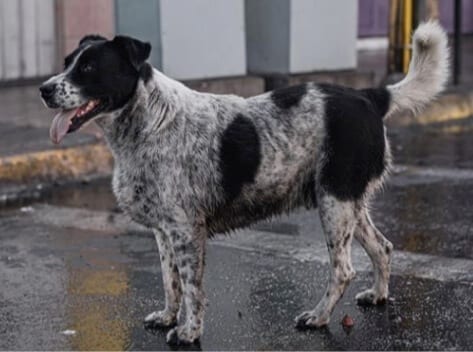
El Vaquita stands on a wet street in Antofagasta after police fired water cannons at protesters. (Source)
A pudgy, black-and-white dog who always seemed to be wagging his tail as he weaved through lines of protesters, Vaquita quickly made a name for himself among student demonstrators. Recorded alongside protesters in different areas of the city, El Vaquita was typically found in the south-central part of Antofagasta. His habit of attending protests and confronting aggressive police officers made him an icon throughout the region. In fact, El Vaquita won the city’s 2019 Character of the Year Award, beating all of his human competitors. Victor Collao, an Antofagasta native who was recently crowned Chile’s greatest karate champion came in second, receiving half as many as votes as Vaquita, devoted riot dog.
In late October, Vaquita accompanied student protesters during the largest marches to date. When police forces met students with violence, El Vaquita became disoriented in the fight. After the dust settled, protesters realized the dog could not find his way back home. They took to Facebook and coordinated a rescue to bring Vaquita back to the areas of the city he knew, and a young man volunteered to walk him back home to south-central Antofagasta.
- More stories: How Ruben Salazar Gave Voice to Chicanos Until He Was Killed by Police
- More stories: The Lives of Ferguson & Black Lives Matter Activists Cut Short
- More stories: How a Retractable Syringe Exposed Powerful Group Purchasing Organizations (GPOs)
Antofagasta’s Support for El Vaquita Through Health Issues
In early January 2020, local reports say that police shot El Vaquita with a rubber bullet. Protesters who were caring for him took him to the vet for treatment, and the pup made a full recovery. When global pandemic hit a couple months later, a stray animal shelter known on Facebook as Antofagasta Dog Community (Comunidad Perruna Antofagasta) took in Vaquita and other stray dogs for a while. But the riot dog was soon back to his normal duties. In July 2020, video emerged of Vaquita spending time with protesters well into the night, wagging his tail all the while.
The city of Antofagasta continues to love and support El Vaquita to this day. For example, when a local story from May 2023 asked for the public’s help in raising money for Vaquita to receive veterinarian care, the community did not disappoint. After it was reported that the cherished protest dog was facing a wide range of health issues after gaining too much weight, locals raised enough money for his rescuer and owner, Luz Echanez, to pursue treatment for Vaquita.

El Vaquita’s owner, @echanez.luz, posts a video of the pup as he recovers at a veterinarian’s office in Antofagasta. (Source)
A little over a month later, it was reported that El Vaquita made a strong recovery. However, the veterinarian who cared for him recommended that the dog retire from his urban life and enjoy his senior years in a loving, consistent home. Today, El Vaquita is spending his golden years with a devoted family, but the city of Antofagasta will always remember his courage on the streets as their beloved riot dog.
El Negro Matapacos at the 2011 Santiago Protests
El Negro Matapacos was a stray dog living on the streets of downtown Santiago, the capital city of Chile and home to more than 5 million people. In 2009, a woman named Maria Campos began to notice this stray dog on her walks through town. She greeted him every so often, and eventually the pup recognized her scent, greeting her back. Over time, this stray dog followed her home and slept outside. On a rainy day, Campos brought the dog in, and Negro Matapacos started spending every night in her home after.

Wearing a red bandana, Negro Matapacos barks at riot police in Santiago. (Source)
Campos lived near the University of Santiago, Chile (USACH). During the dog’s daily walks through the city, he began hanging around the university students living on campus. After a while, the students became accustomed to their new furry friend and “adopted” him, though El Negro Matapacos still spent his nights in Campos’ home. To ensure he would be able to find his way back, Campos gave the dog a collar with her phone number, as well as a cape that he wore everyday.
During the summer of 2011, massive student-led protests boiled over throughout Chile. These young protesters called for greater equality in education and the creation of a national public education system, among other demands. A public university had not been built in the country since 1990, and less than half of Chilean high school students attended public school at the time.
- More stories: Israel Has Killed Record Numbers of Journalists & Aid Workers in 6 Months
- More stories: Police Shootings of Latinos in Los Angeles 2016 – 2021
One day, Campos received a call from students about Negro Matapacos: He was standing alongside them against police in a nearby protest. When the riot dog returned home that night, his cape was soaking wet from water cannons fired by police. Campos switched to handkerchiefs for her newly designated riot dog, and ] Negro Matapacos, whose name translates to “Black Cop-Killer,” was running around the city with red or blue bandana.
Early August 2011 saw the largest demonstrations in Santiago, during which police shot water cannons and tear gassed thousands of protesters. El Negro Matapacos was at the forefront of many of these protests, barking, growling, and charging police as they threatened and beat student protesters. Everyday, the riot dog ran with protesters, showing his teeth and barking at the lines of police officers who attacked them.
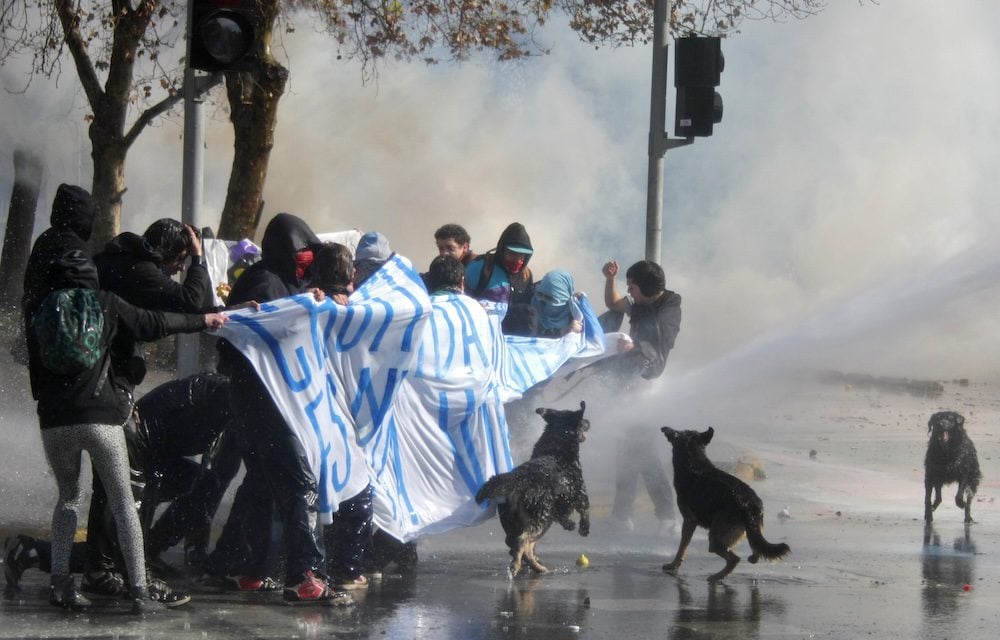
Stray dogs run toward the spray from a water canon aimed at protesters by police in Santiago on July 14, 2011. (AP Photo/Sebastian Silva)
Student protesters said that El Negro Matapacos always understood which side was the enemy, with one demonstrator saying the pup “knew without question which uniform to bark at and which to defend.” Countless photos show this riot dog facing off with police, pacing back and forth among the front lines of protesters, and getting sprayed with water hoses.
In August 2017, Negro Matapacos died of natural causes. However, the legacy of the beloved riot dog was just beginning. He became a national Chilean symbol of resistance amid ongoing national divisions. Two years after he died, images of the protest dog appeared everywhere, including on murals, protest signs, stickers, and online throughout the country. Symbols and art of Negro Matapacos are usually accompanied with protest slogans, including “Resist” and “By the force of reason.”
This Chilean riot dog even appeared during New York City’s fare-dodging protests after police officers pulled their guns on a teenager for fare-dodging in a crowded subway. Stickers of El Negro Matapacos jumping subway turnstiles appeared on terminal walls during the height of demonstrations in late 2019.
Riot Dog Loukanikos at Athens Protests, 2009 – 2012
During the anti-austerity movement in the wake of the Great Recession, large-scale protests erupted in Athens, Greece. At demonstrations and ensuing encounters with the police, protesters and journalists began to notice a stray dog who was particularly vicious to riot police and exceptionally protective of the groups. Loukanikos (or Λουκάνικος, meaning “Sausage”), was a stray who became a famous Greek riot dog known for his heroics in the thick of violent clashes with police from approximately 2009 to 2012.
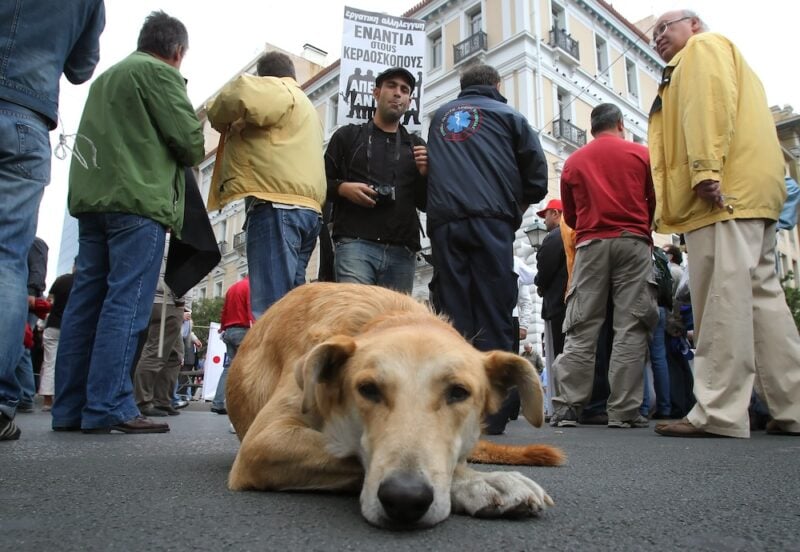
A stray dog who is likely, though not confirmed to be Loukanikos, rests as protesters gather before the start of a rally in Athens in October 2010. (AP Photo/Petros Giannakouris)
In videos taken of the protests, Loukanikos is seen running through lines of riot police, barking and growling at the organized forces before returning to the anarchists’ front line. Similarly with Negro Matapacos and Vaquita, Loukanikos was often seen at the very front of public demonstrations.
Nicknamed Louk by locals, this famous protest dog was known to hold his ground with police and even try to form a protective line by running back and forth between protesters and authorities. As a result, he also faced violence from the militarized forces clashing with protesters in Athens. A photographer in the fray caught one such instance where a cop barely missed kicking Louk as the riot dog leapt out of reach.
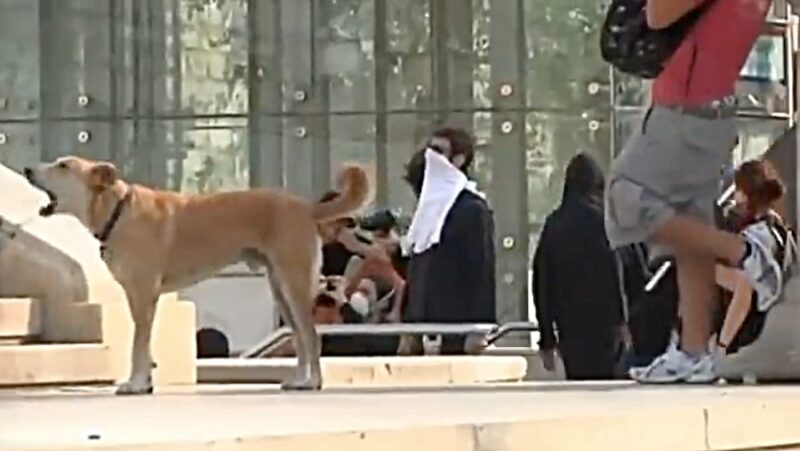
Loukanikos barks at police officers amid daily protests in Athens. (Source)
Recognizing the danger of tear gas canisters in the street, Loukanikos learned to pick them up and move them away from protesters, and attempted to do so often. There is an incredible 2011 photo of the riot dog, hair on end, bending over a spewing canister and opening his mouth wide to grab it as demonstrators look on.
- More stories: When Columbia Expelled Robert Burke for Anti-Nazi Protests in 1936
- More stories: Jovita Idár’s Fight for Mexican-American Rights in Texas
- More stories: Yuri Kochiyama at Intersection of Black Power & Asian Movements
Loukanikos’ Later Life
Over the years of protecting Greek protesters, Loukanikos endured heavy exposure of tear gas and other life-endangering chemicals from police. When the dog’s health began to deteriorate, Louk “retired” from protesting.

A riot dog that looks like it may be Loukanikos, though unconfirmed, runs toward the group of demonstrators as a protester throws a stone toward riot police in central Athens on January 9, 2009. (AP Photo/Petros Giannakouris)
Loukanikos lived in a loving home with a man who was caring for him until his death on May 21, 2014. According to a local newspaper called I Avgi, Louk’s death was partly attributed to daily exposure of tear gas and police chemicals, as well as physical trauma caused by police kicking him. He is believed to have been about 10 years old when he passed.
Loukanikos, the fearless Greek riot dog cherished by Athens, is buried in a grassy area under a tree in the center of the city.
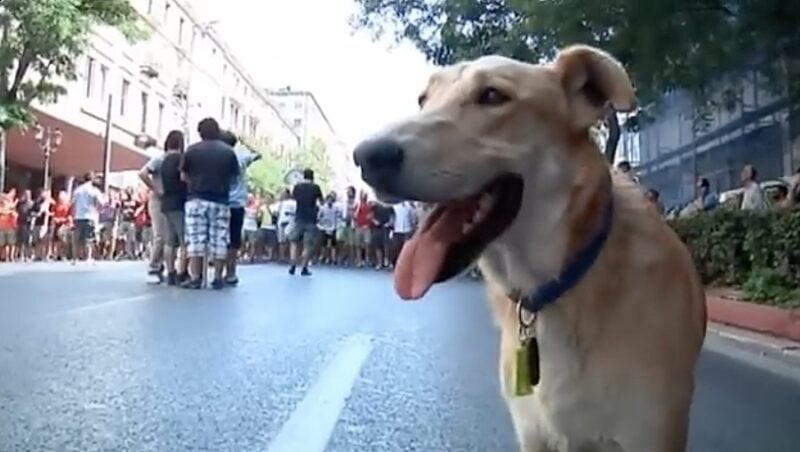
Loukanikos, Athens’ tenacious and iconic riot dog. (Source)
Kanellos, Greece’s First Modern Riot Dog
Kanellos (or Κανέλο, meaning “Cinnamon”) is largely considered the first riot dog of the modern era. As a stray in Greece, Kanellos began to hang around the National Technical University of Athens (NTUA) and bonded with the students who lived there. Over time, Kanellos found a home at the school, and he was well-cared for by each incoming class of students who lived on campus each year.
As the financial crisis in Greece hit new lows in February 2007, Kanellos ran alongside students and other protesters as they faced off against police. The earliest footage of Kanellos comes from a 5-second clip of him running with protesters as fires burn behind them. The riot dog would typically protest with the students during the day, and return with them to campus at night.

Kanellos runs alongside Greek protesters in a 2007 video. (Source)
When NTUA hired a dogcatcher and removed Kanellos from campus grounds in June 2007, the students shared a petition with hundreds of names and demanded that the school provide “his immediate return to the place where he lived for more than a decade.” The university listened, and Kanellos was eventually placed back in the care of students.
Like the riot dogs who came after him, Kanellos was aggressive with police and protective of protesters. He was consistently found at the front of marches, making himself into a barrier between the anarchist protesters and police. One photo captures Kanellos laying down in front of rows of riot cops turned toward students.
- More stories: How Isaac Wright Jr Overturned Life Sentence & Became a Lawyer
- More stories: Wheelchairs & Airlines: Why Is Flying So Risky for Those With Disabilities?
In late 2007, Kanellos developed severe arthritis and lost the ability to walk. University students raised money and bought him a doggy wheelchair so that wheels would serve as his back legs. In February 2008, Kanellos walked alongside protesters in Athens for the final time. On July 2, 2008, Kanellos passed away in the care of university students. The first famous protest dog of the modern era is believed to have died somewhere in his teens, having lived a very long and fulfilling life.
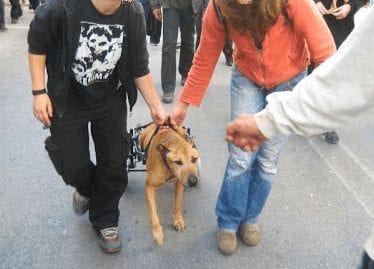
With the help of a doggy wheelchair, Kanellos walks with protesters in Athens for the last time. (Source)
Conclusion
As a general rule of thumb, when a dog doesn’t like somebody, that person probably deserves a second look. So when riot dogs across the globe choose to protect protesters in direct opposition to the militarized police they’re facing off against, perhaps there’s something to be learned for the rest of us. After all, a dog’s instincts don’t lie.

A mural depicting Loukanikos, the stray dog turned famous symbol of Greek resistance, is painted on a wall in Athens as a pedestrian walks by on October 25, 2014. (AP Photo/Kostas Tsironis)






I cried the whole time reading this. ????????